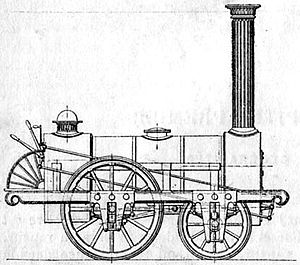Planet (locomotive)
| planet | |
|---|---|
|
Drawing from the book La Machine Locomotive from 1899
|
|
| Number: | 10 |
| Manufacturer: |
Robert Stephenson & Co. , Newcastle Fenton, Murray and Jackson |
| Year of construction (s): | 1830 |
| Type : | 1A n2 |
| Gauge : | 1435 mm ( standard gauge ) |
| Length: | 7.42 m |
| Service mass with tender: | 13.5 t |
| Wheel set mass : | 5 t |
| Top speed: | approx. 60 km / h |
| Starting tractive effort: | 6.6 kN |
| Driving wheel diameter: | 1575 mm |
| Number of cylinders: | 2 |
| Cylinder diameter: | 292 mm |
| Piston stroke: | 406 mm |
| Boiler overpressure: | 3.5 bar |
| Number of heating pipes: | 25 3-inch diameter copper flame tubes |
| Grate area: | 0.67 m² |
| Evaporation heating surface: | 38 m² |
| Water supply: | about 1.8 m³ |
| Fuel supply: | about 1 ton of coke |
Planet was an early steam locomotive delivered to the Liverpool and Manchester Railway in 1830 by George and Robert Stephenson . It is considered to be the first steam locomotive with two cylinders lying horizontally in front of the driving axle - an arrangement that from then on was used in most steam locomotives and the first steam locomotive to be produced in large numbers.
The Planet was delivered shortly after the runway opened in October 1830. Compared to the Northumbrian , which was completed a few weeks earlier, the cylinders on the Planet were not arranged behind the drive axle outside the wheels, but rather lying in front of the drive axle between the wheels. This resulted in a more balanced weight distribution, with the cylinder being carried mainly by the barrel axis and the fire box by the driving axis.
The arrangement of the cylinders between the wheels was intended to improve the running of the track compared to the Northumbrian by transferring the force to the drive axle as close to the center of the track as possible and thereby counteracting the rolling. However, it required a double-cranked drive axle , which was difficult to manufacture. In addition, the drive rod bearings also had to be divided so that they could be attached to and removed from the bolster axis. The split bearings were weaker and more difficult to manufacture than a one-piece design.
The planet proved itself. On November 23, the locomotive had covered the 35 miles (35 miles) from Liverpool to Manchester in just one hour. In December 1830, the Planet pulled the first freight train of the Liverpool and Manchester Railway, the weaker locomotives previously delivered were not suitable for freight transport. Robert Stephenson & Co. delivered six other locomotives of the same design to the railroad in addition to the number 9 listed. Next built Fenton, Murray and Jackson from Leeds after drawings by Stephenson, the three locomotives 19 Vulcan , 21 Flury and 30 Leeds for the Liverpool and Manchester Railway.
Replica
A working replica of the planet was completed in 1992 by the Friends of the Museum of Science and Industry (MOSI) in Manchester . It is run by volunteers from the museum who offer guests rides on the locomotive. When the locomotive is not under steam, it is displayed in the museum's Power Hall. It has also been used on other museum railways , such as the Shildon Locomotion Museum .
Web links
Individual evidence
- ^ A b Liverpool & Manchester Railway. In: Steamindex. Retrieved August 25, 2013 .
- ^ Brian Hollingsworth: The Illustrated Directory of Trains of the World . MBI Publishing Company, 2000, ISBN 0-7603-0891-8 , pp. 12–13 ( full text in Google Book Search).
- ^ Basic Info on the Stephensons. Stephenson Locomotive Society, accessed August 25, 2013 .
- ^ Steam Train Rides. (No longer available online.) Museum of Science and Industry, archived from the original on July 3, 2014 ; accessed on August 25, 2013 .

